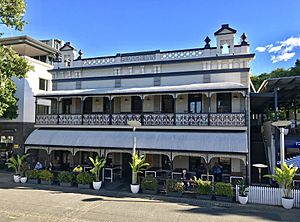Plough Inn facts for kids
Quick facts for kids Plough Inn |
|
|---|---|

Plough Inn, 2018
|
|
| Location | South Bank Parklands, South Brisbane, City of Brisbane, Queensland, Australia |
| Design period | 1870s - 1890s (late 19th century) |
| Built | 1885, extended 1922 |
| Built for | Daniel Costigan |
| Architect | Alexander Brown Wilson (1885), George Henry Male Addison and Son (1922) |
| Official name: Plough Inn, Plough Inn Hotel | |
| Type | state heritage (built) |
| Designated | 21 October 1992 |
| Reference no. | 600294 |
| Significant period | 1885-1922 (fabric) 1885-0ngoing (historical, use as hotel) 1987 (historical), Expo 88 modifications |
| Significant components | kitchen/kitchen house |
| Builders | Abraham James (1885), Robertson and Corbette (1922) |
| Lua error in Module:Location_map at line 420: attempt to index field 'wikibase' (a nil value). | |
The Plough Inn is a historic hotel located in the South Bank Parklands in South Brisbane, Queensland, Australia. It's a two-story building that has been around for a long time. It was first built in 1885 and has seen many changes since then. Today, it's still a popular spot in South Bank.
Contents
History of the Plough Inn
Building a New Hotel
The Plough Inn we see today was built in 1885. It replaced an older, smaller building that had been called the Plough Inn since 1864. This new building was constructed during a busy time for South Brisbane. Many buildings on Stanley Street were being rebuilt in the 1880s.
The famous architect Alexander Brown Wilson designed the hotel. He was known for designing homes. Abraham James was the builder, and his offer of £3,300 was accepted in March 1885.
A Busy Location
The hotel was in a great spot on Stanley Street. This area was the main business center of South Brisbane. It was also very close to the South Brisbane wharves, where ships loaded and unloaded goods. This made the Plough Inn very popular with people working in shipping.
What the Hotel Looked Like Inside
When it first opened, the hotel had an L-shape inside. On the ground floor, there was a main hall, a staircase, a dining room, and two private rooms. It also had a bar, a parlor, storage areas, a billiard room, and restrooms.
Upstairs, on the first floor, there were fourteen guest rooms and a bathroom. A verandah (a covered porch) at the back connected the main building to a separate kitchen building. There was also a cellar downstairs.
Changes Over Time
The Plough Inn has been changed many times since it was first built. In 1922, more parts were added. These additions were designed by George Henry Male Addison and Son, and built by Robertson and Corbette. It's thought that the covered walkway over the street was added around this time.
In 1987, the building was changed again to become a tavern for Expo '88. Many of the inside walls were removed. The central fireplace and chimney were taken out, and the inside was completely redone. The front verandah was made wider, and the back verandah was made longer. Windows and doors were also replaced.
Later, in 1991-1992, the inside of the Plough Inn was fully updated. The front verandah was also rebuilt to look like it used to.
Today, the Plough Inn still operates as a hotel in the South Bank area.
What the Plough Inn Looks Like
The Plough Inn is a two-story building made of stone covered in plaster. It has verandahs at the front and back. There's also a smaller building at the back for services. The front of the building is very detailed and pretty. It's a reminder of how the street used to look.
The hotel has an L-shaped design. The service building at the back is connected by the rear verandah.
The front of the building, called the facade, has lots of fancy details. It has three sections with pilasters (flat columns) that look like they're made of rough stone. There are also decorations on the top wall, called a parapet. These include triangle shapes called pediments on each end and a sign in the middle that says "PLOUGH INN."
Even though the inside of the hotel has changed a lot, the outside of the Plough Inn still looks much like it did when it was first built.
Why the Plough Inn is Important
Queensland Heritage Listing
The Plough Inn was added to the Queensland Heritage Register on October 21, 1992. This means it's considered an important historical place in Queensland.
It's important for a few reasons:
- It shows how Queensland's history has changed. The beautiful front of the Plough Inn, along with the nearby Allgas Building, is one of the few parts left of what Stanley Street used to look like. Stanley Street was the main business street in South Brisbane in the late 1800s.
- It's a rare part of Queensland's history. The Plough Inn is one of the few buildings left from the busy business and shipping area of South Brisbane in the late 1800s.
- It's beautiful to look at. The detailed front of the building helps us imagine what the old Stanley Street looked like.
- It's connected to an important person. The hotel is strongly linked to the work of the well-known Brisbane architect, Alexander Brown Wilson.
Stories of Hauntings
Some people have shared stories about a ghost at the Plough Inn. These stories say that a young woman or girl haunts near or in room 7. People haven't reported seeing the ghost, but they say they've heard her walking in the halls.
A paranormal investigator named Joe Nickell looked into these stories. He explained that the stories change a bit each time they are told. This is a sign of folklore, where stories are passed down and changed a little for fun or to make them more interesting.

